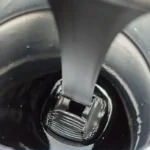What is Cutback Bitumen? | Types, Uses & Advantages Explained
Cutback Bitumen is a type of bitumen that has been modified by adding a solvent, typically a petroleum distillate, to reduce its viscosity and make it easier to handle and apply. The addition of a solvent allows the bitumen to become more fluid at lower temperatures, making it suitable for a variety of construction and maintenance applications.
What Is Cutback Bitumen?
Cutback Bitumen is simply bitumen diluted with a volatile solvent to reduce its viscosity. This makes it more fluid at ambient temperatures and suitable for cold or moderate weather applications, unlike conventional bitumen which requires heating before use.
After application, the solvent gradually evaporates, leaving a film of pure bitumen to bind aggregates or coat surfaces.
Composition of Cutback Bitumen
-
Base bitumen (typically 60/70 or 80/100 penetration grade)
-
Petroleum-based solvent like:
-
Kerosene
-
Naphtha
-
Diesel
-
The ratio of solvent determines how fast the bitumen “sets” or cures, creating different setting types.
🕒 Types of Cutback Bitumen (Based on Setting Time)
| Type | Description | Setting Time | Common Use |
|---|---|---|---|
| Rapid Setting (RS) | High-volatility solvent (e.g. naphtha) | Fast (minutes) | Spray sealing, surface dressing |
| Medium Setting (MS) | Moderate-volatility solvent (kerosene) | Medium (hours) | Premix for cold-mix asphalt |
| Slow Setting (SS) | Low-volatility solvent (diesel/oil) | Slow (days) | Prime coat, dust control |
It is classified based on the type of solvent used and the curing time. Some common types of cutback bitumen include rapid curing (RC), medium curing (MC), and slow curing (SC).
Rapid curing (RC) contains a high concentration of solvent, allowing it to cure quickly. It is commonly used for applications where rapid setting and drying times are required, such as surface treatments, patching, and crack sealing.
Medium curing (MC) has a lower concentration of solvent compared to rapid curing types. It provides a balance between curing time and workability, making it suitable for various applications, including prime coats, tack coats, and seal coats.
Slow curing (SC) has the highest viscosity and the lowest solvent content. It is primarily used for applications that require a longer curing time, such as fog seals and slurry seals.
⚙️ Applications of Cutback Bitumen
It is used in various construction and maintenance operations where heating is not practical:
-
Prime coat on unbound base layers
-
Tack coat between asphalt layers
-
Cold-mix asphalt production
-
Surface treatments and spray sealing
-
Dust suppression on unpaved roads
The solvent used in cutback bitumen can vary, but common options include gasoline, kerosene, diesel, or a combination of these. The choice of solvent depends on factors such as the desired curing time, environmental considerations, and the specific application requirements.
✅ Advantages of Cutback Bitumen
-
Requires no heating, improving safety
-
Ideal for cold climates or remote sites
-
Penetrates porous surfaces effectively
-
Easier to handle and apply than hot bitumen
Cutback Bitumen offers several advantages in construction and maintenance projects. It provides improved workability and easier application compared to neat bitumen. The lower viscosity of cutback bitumen allows for better coating and penetration of aggregates, resulting in improved adhesion and durability.
❌ Disadvantages of Cutback Bitumen
-
Solvent evaporation can be hazardous to the environment
-
Air quality regulations may restrict usage
-
Longer cure times in some cases
-
Flammable due to petroleum solvents
🌍 Note: Due to environmental concerns, many countries are replacing cutbacks with emulsified bitumen.
However, it is important to note that cutback bitumen contains volatile organic compounds (VOCs) due to the presence of solvents. Proper safety measures and environmental considerations should be taken when handling and applying cutback bitumen to minimize health and environmental risks.
Cutback Bitumen Grades (Examples)
| Grade | Use Case | Base | Description |
|---|---|---|---|
| RS-1 | Tack coat | 60/70 | Fast-setting, light spray |
| RS-2 | Surface dressing | 60/70 | Heavier spray applications |
| MS-1 | Cold-mix asphalt | 80/100 | Premix use |
| SS-1 | Prime coat | 80/100 | Penetrative, long setting time |
Why choose Pars Universal Bitumen?
At Pars Universal Bitumen, we supply a complete range of Cutback Bitumen types and grades tailored to project requirements:
-
🛢️ RS-1, RS-2 for spray seals
-
🏗️ SS-1, SS-2 for prime coats
-
🧊 MS grades for cold-mix asphalts
-
📦 Bulk or drum packaging
Why Choose Us?
-
🌍 Export-ready documentation
-
🧪 Consistent product quality & COA
-
💼 Technical support & sourcing advice
-
📈 Competitive rates for global markets
FAQs About Cutback Bitumen
Q1: Is it same as bitumen emulsion?
No. While both are cold-applied, emulsions are water-based, while cutbacks are solvent-based.
Q2: Why is it called ‘cutback’ bitumen?
The term “cutback” refers to the solvent cutback bitumen the viscosity of the bitumen.
Q3: Can it be stored for long?
Yes, in sealed containers and away from ignition sources. However, solvent loss over time can affect performance.
Q4: Is it eco-friendly?
Not particularly. The release of VOCs (volatile organic compounds) during evaporation is an environmental concern.
Q5: What’s the difference between RS and SS?
RS sets quickly and is used for surface applications; SS sets slowly and is better for prime coating or penetration.
📆 Conclusion: Why Cutback Bitumen Still Matters in Road Construction
Cutback Bitumen remains a practical and reliable solution for roadwork, especially in environments where heating traditional bitumen is not feasible. Its versatility in prime coats, tack coats, and cold-mix applications makes it a go-to material for engineers and contractors needing ease of application and strong surface bonding.
While environmental regulations have prompted a shift toward bitumen emulsions in some regions, cutback bitumen continues to serve a critical role in infrastructure projects worldwide—particularly in remote, cold, or logistically limited locations.
At Pars Universal Bitumen, we offer a full range of cutback bitumen grades (RS, MS, SS)—backed by technical expertise, export documentation, and global delivery solutions. Whether you’re paving a rural road or preparing a base layer, we’re here to supply the performance you need, when and where you need it.
📞 Contact Pars Universal Bitumen
Let’s supply your next road construction or maintenance project with high-quality cutback bitumen.
📧 Email: [email protected]
📞 Phone: +971 4 878 2031
🌐 Website: Pub-ltd
📝 Request a Quote Today or consult our team for the right cutback grade for your region or application. If You have any other Query or Question you want to ask, Please don’t hesitate to Contact Us.





